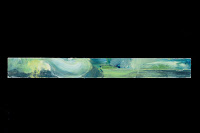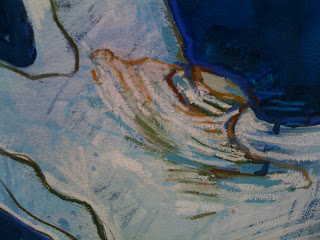


 Among the many inspiring murals throughout San Francisco, Tonantzin Renace is not to be missed. This sensational mosaic relief mural of the fiery red Lady , unparalleled anywhere in the city, can be seen at 3495 16th St. and Sanchez. Colette Crutcher lives and works in San Francisco, creating several mosaic masterpieces around the city including this incredible Mayan Quetzalcoatl ( seen above) sculpture located in the Mission district at 24th St. and York. One of her latest feats is the astounding community steps project located at 16th Avenue and Moraga in the Sunset district. Aileen Barr, also a local artist who creates her own tiles, shared her skills with Colette to help create the hand made tiles and worked with Colette to design the steps. With Aileen's ceramic knowledge and Colette's mosaic experience, the two artists work were wed. Jessie Audette and Alice Yee Xavier are responsible for proposing the idea and helped organize the project. Together, everyone raised enough money, $120,000, to create and complete the 163 steps mosaic design. (left image just below)
Among the many inspiring murals throughout San Francisco, Tonantzin Renace is not to be missed. This sensational mosaic relief mural of the fiery red Lady , unparalleled anywhere in the city, can be seen at 3495 16th St. and Sanchez. Colette Crutcher lives and works in San Francisco, creating several mosaic masterpieces around the city including this incredible Mayan Quetzalcoatl ( seen above) sculpture located in the Mission district at 24th St. and York. One of her latest feats is the astounding community steps project located at 16th Avenue and Moraga in the Sunset district. Aileen Barr, also a local artist who creates her own tiles, shared her skills with Colette to help create the hand made tiles and worked with Colette to design the steps. With Aileen's ceramic knowledge and Colette's mosaic experience, the two artists work were wed. Jessie Audette and Alice Yee Xavier are responsible for proposing the idea and helped organize the project. Together, everyone raised enough money, $120,000, to create and complete the 163 steps mosaic design. (left image just below)WOW!!!

I previously had the privilege of living in the same neighborhood as Colette and could visit her Lion, Wise and Furry, at whim. We can see more of Colette's incredible work on her website at www.colettecrutcher.com. You can also purchase a book about the 163 steps recently completed in the city to support their work and cover the cost of the publishing. Also noted and not to be missed here is the detailed relief sculpture created by her artist husband, Mark Roller ( circular relief seen below). The two have worked on several projects together, most easily seen on the Quetzalcoatl sculpture mentioned earlier.

Finally, to learn more about the murals of San Francisco, visit www.cityhikes.com. OR www.precitaeyes.org.







































